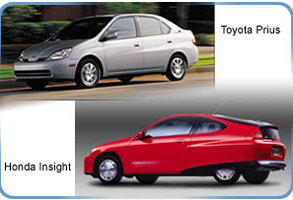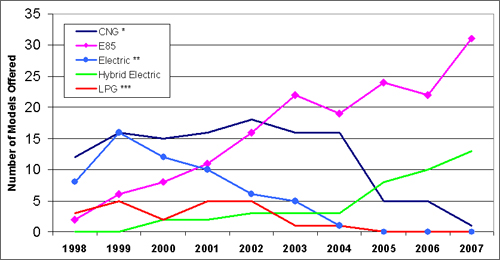Absrtact
This study investigates the demand for alternative vehicles and defines the market in hopes that the American auto producers will take up the challenge and put themselves in the forefront of the production and marketing of affordable environmentally friendly vehicles for the American consumer. It would help the environment, the consumer, the auto producer and the country. If we do not meet this demand, foreign auto makers will, and our workers and economy will miss out on this market development. The report covers:
- The definition of a hybrid car
- Forms of other alternatively-powered cars currently on the market in development
- How this type of car meets the present crisis
- The level of public demand for this type of car
- A comparison of alternative cars currently on the market
- An investigation of why alternative cars don’t seem to be more in demand
- An investigation into the specific dangers and safety issues of hybrid cars
Executive Summary
American car makers are missing out on a potentially huge market as American consumers begin the race to purchase alternatively powered vehicles that will both serve their needs and reduce their monthly energy costs. Recent gas prices have illustrated the need for an alternate means of transportation and hybrid cars are one way of meeting that need. One form of hybrid is the plug-in electric. This type of car uses electricity almost exclusively for the first 40 miles or so, depending upon the storage capacity of the battery, and then switches to a modified internal combustion engine. “Its battery/electric motor combination provides the quick starts, so when the vehicle is standing still, the gas engine can be shut off automatically to prevent idling and conserve fuel. In fact, the hybrid can achieve an increase in fuel efficiency of roughly 30 percent. The battery also boosts the performance of the [internal combustion engine] at takeoff and for passing” (Sanna, 2005). Other types of hybrid or alternatively powered vehicles have reached the marketing stage at home and abroad. Maximum consumer development is achieved by ensuring the vehicle is immediately available for use, meaning its power source must be already readily available.
Introduction
Although there is an increasing demand for hybrid or alternatively-powered vehicles in the marketplace right now, there is a surprising lack of research and development of these ideas by the car companies themselves. A great deal of money stands to be made by the car maker who steps forward and aggressively pursues the development of vehicles that use little or no petroleum products as a source of fuel. By developing alternatively-powered vehicles, a car maker can also establish itself as being environmentally friendly, highly competitive with foreign markets and friendly to the consumer, all of which will go a long way toward building and maintaining a loyal consumer base. This is all proven by exploring the current levels of alternative fuel vehicle development, the present consumer demand for such vehicles and the reasons why consumer demand doesn’t seem to be as high as it is.
Scope of the Study
This study focuses on the market readiness and demand for hybrid and alternative vehicles. A brief definition and description of these vehicles is included. The issues for development are covered. Consumer readiness is the main focus of this study with the inclusion of why there are not more sales, and what can change this, plus the reasons we need for U.S. auto producers to move forward with this as rapidly as practical.
Research covered:
- The current state of development
- The current state of the market
- The reasons for demand
- The reasons demand is not higher
Report Format
Main body include the report on research findings and suggestions. Ther APPENDIX contains charts useful for clarification. All sources are cited in the bibliography.
Consumer Demand
Vehicles that provide any degree of fuel efficiency technology are generally not perceived by American companies to have any high degree of popularity among their general consumer base. Despite this, alternatively powered vehicles, once made practically available, have always proven to be very popular. In 2005, when gas prices were still hovering at the relatively low price of $2/gallon, Smith reported, “a check with several dealers suggests there’s at least a four-month wait for a Prius, with one dealer saying eight months. For the Lexus RX 400h, a 2006 model, one dealer said he’s already taking deposits for the 2007s” (Smith 2005). As gas prices begin to soar above $5 per gallon and more, American families are having to do without dinner in order to pay for gas to go to work tomorrow. In addition, the price of that dinner is up from 5%-15%, due to the high cost of fuel. The demand for efficient alternative fuel transportation will only continue to increase, as the price of oil will never drop back to the levels of even one year ago.
Current Development of Hybrids and Alternative Vehicles
There are many forms of hybrid and alternatively-powered vehicles currently in development, many of which use a completely different form of fuel and it is here that the vehicles seem to lose their popularity. The form of energy each of these vehicles use determines the level of environmental impact each vehicle will have. This roughly translates to indicate the level of fuel efficiency and gas savings a consumer can expect by using it and, generally, their chief priority in making the purchasing decision. However, the savings benefit is severely curtailed by unavailable resources. Engines that run on biofuel developed from seaweed may be the most economical form of alternative vehicle in the future, but this will mean little if refilling stations can’t be convinced to carry the product, which will not happen until consumer demand, as a result of an available vehicle, forces it.
Current Offerings:

One hybrid on the road is the Toyota Prius. This four-person car gets 52 mpg. It uses advanced technology to combine a small gas engine with an electric motor. At very slow speeds, the car runs on its electric motor. Driving around the city and at higher and freeway speeds, it shifts to both the gasoline motor and the electric motor, while also recharging the battery.
The Honda Insight, which can get up to 68 miles per gallon on the freeway. The car uses a small 1.0 liter, 3-cylinder engine with an ultra-thin electric motor.
Source of above information and pictures: Transportation Energy: A Student’s Guide to Alternative Fuel Vehicles (2008).
*See Appendix B for a list of Currently available models.
We are also aware of the hybrid Ford Escape and the hybrid Dodge Durango. However, we believe that the several weeks to several months waiting time for U.S. hybrids in a disincentive to purchase these cars. U.S. auto makers need to realize that the days of convincing consumers to purchase a gas guzzling dinosaur are gone forever and they need to ramp up production of a whole new model line.
Issues in Consumer Demand
Tax Credit Needs Updating and Improving
The Energy Policy Act of 2005 replaced the clean-fuel burning deduction with a tax credit. A tax credit is subtracted directly from the total amount of federal tax owed, thus reducing or even eliminating the taxpayer’s tax obligation. The tax credit for hybrid vehicles applies to vehicles purchased or placed in service on or after January 1, 2006. The credit is only available to the original purchaser of a new, qualifying vehicle. If a qualifying vehicle is leased to a consumer, the leasing company may claim the credit. (Internal Revenue Service 2008)
- This reflects a decrease in the credit amount as of Oct. 1, 2006, due to the manufacturers meeting quarterly sales of 60,000 qualified hybrid cars — See Quarterly Sales, below.
- This credit amount does not phase out. The full amount of the altenative fuel vehicle credit would be available for vehicles purchased on or before December 31, 2010.
Qualifed Cars and Credit Amounts are listed in charts in APPENDIX A.
Due to the unnecessary complexity of this credit it is urged upon the congress to replace it with a more comprehensive model which will also favor American cars, prodiving anough stock is available.
Conclusions
American car companies have failed to serve the needs of the public that supports them, but it isn’t too late for them to emerge as the celebrated gladiators at the gate. Consumer demand, already high, will only continue to increase for products that don’t depend upon foreign sources of energy. The primary retardant factor in raising consumer demand to a fever pitch is in the unavailability of immediate delivery and sufficient models, and the energy supplies to power these vehicles. Since it is not likely that the oil companies are going to get behind adding the alternative fuels at gas stations, it is suggested that car dealers work out some way to make them easily available at local stations everywhere. Technology exists that could use existent resources, such as electric generators and refilling stations that need only include or convert a fuel tank. As alternatively-powered vehicles become more readily available to the average car consumer, these resources will be demanded and supplied, but the car has to be available first.
Appendix A
2005 Model Year Hybrid Vehicles
* Credit for Toyota/Lexus vehicles are reduced for purchase after 10-1-06. See Notice 2006-78 for additional information.
** Credits for Honda vehicles are reduced for purchase after 1-1-08. See Notice 2007-98 for additional information.
2006 Model Year Hybrid Vehicles
* Credit for Toyota/Lexus vehicles are reduced for purchase after 10-1-06. See Notice 2006-78 for additional information.
** Credits for Honda vehicles are reduced for purchase after 1-1-08. See Notice 2007-98 for additional information.
2007 Model Year Hybrid Vehicles
* Credit for Toyota/Lexus vehicles are reduced for purchase after 10-1-06. See Notice 2006-78 for additional information.
** Credits for Honda vehicles are reduced for purchase after 1-1-08. See Notice 2007-98 for additional information.
2008 Model Year Hybrid Vehicles
Appendix B
Fact #499: December 10, 2007.
Alternative Fuel Models: Gains and Losses.
The graph below shows that there were more than 30 light vehicle models that run on E-85 in the 2007 model year (MY). In MY 2005 there was an increase in hybrid-electric models offered, but that also was the first year that no LPG or electric vehicles were offered. Only one model that runs on CNG was available in MY 2007.
Alternative Fuel and Hybrid Electric Light Vehicle Model Offerings by Model Year, 1998-2007.

* CNG includes both dedicated and bi-fuel vehicles.
** Electric vehicles do not include neighborhood electric vehicles, low speed electric vehicles, or two-wheeled electric vehicles.
*** LPG includes both dedicated and bi-fuel vehicles.
Note:
- E-85 = 85% ethanol and 15% gasoline
- CNG = Compressed Natural Gas
- LPG = Liquefied Petroleum Gas, also known as Propane
Supporting Information
Alternative Fuel and Hybrid Electric Light Vehicle Model Offerings by Model Year, 1998-2007
* CNG includes both dedicated and bi-fuel vehicles.
** Electric vehicles do not include neighborhood electric vehicles, low speed electric vehicles, or two-wheeled electric vehicles.
*** LPG includes both dedicated and bi-fuel vehicles.
Note:
- E-85 = 85% ethanol and 15% gasoline
- CNG = Compressed Natural Gas
- LPG = Liquefied Petroleum Gas, also known as Propane
Source: U.S. Department of Energy, Alternative Fuels Data Center, “AFV/HEV Light-Duty Model Offerings by Fuel Type, Trend of AFV models capable of using various fuel types and HEVs using gasoline from 1991-2007.”
Works Cited
Internal Revenue Service, 2008, Web.
Sanna, Lucy. “Driving the Solution: The Plug-in Hybrid Vehicle.” EPRI Journal. Fall, 2005.
Smith, S. “More Hybrid Models on the Way.” Cars.com. (2005). Web.
Transportation Energy: A Student’s Guide to Alternative Fuel Vehicles (2008). Web.
U.S. Department of Energy, 2008, Web.